THE CORD
CHRISTMAS HISTORY
TACKLING






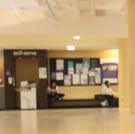



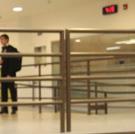










newspaper are those of the world around it, and so e Cord will attempt to cover its world with a special focus on Wilfrid Laurier University, and the community of Kitchener-Waterloo, and with a special ear to the concerns of the students of Wilfrid Laurier University. Ultimately, e Cord will be bound by neither philosophy nor geography in its mandate.


e Cord has an obligation to foster freedom of the press and freedom of speech. is obligation is best ful lled when debate and dissent are encouraged, both in the internal workings of the paper, and through e Cord’s contact with the student body.













e Cord will always attempt to do what is right, with fear of neither repercussions, nor retaliation. e purpose of the student press is to act as an agent of social awareness, and so shall conduct the a airs of our newspaper.

Haldimand tract, traditional territory of the Neutral, Anishnaabe and Haudenosaunee peoples. is land is part
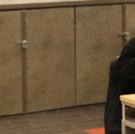
mission has occurred, that error shall be acknowledged promptly. When statements are made that are critical of an individual, or an organization, we shall give those a ected the opportunity to

What do you do over the holidays?
"My favourite thing to do is relax with the family and binge eat all the home cooked meals my mother can make.."
- Devishi Chopra, 2nd year BBA/FinMath
"I spend my time trying and making festive snacks and drinks, watching Christmas movies, and sleeping in."
- Sherman Syeda, 1st year computer science
"I am looking forward to watching my favourite Christmas movies and baking cookies"
- Ummiyal Thibakaran, 1st Year political scienceABIGAIL HECKBERT/CORD PHOTOGRAPHY
"I am looking forward to visiting family in Atlanta.."
-Huzaifa Saeed , 2nd year BBANEWS DIRECTOR VACANT news@thecord.ca EDITOR JAMES WINSLOW news@thecord.ca

Kalends of January (similar to celebrations of the New Year).
JAMES WINSLOW NEWS EDITORFew people, if any, know the world’s most popular holiday as intimately as Gerry Bowler, author of four books on Christmas and a history professor at the University of Manitoba researching the intersection of religion and popular culture.
e original religious inspiration for Christmas, as the symbol of the nativity scene suggests, has everything to do with the birth of Jesus Christ.
“...Early Christians seemed not to have been interested in celebrating the birth of Jesus,” Bowler explained.
Interest was only stoked when Gnostics began asserting a disembodied view of the Christian messiah.
“When Gnostics began to suggest that he never had a body, that he had never su ered physically, that he had never been born physically, Christians began to be interested in asserting the corporeality of Jesus,” Bowler said. “Celebrating the birth of Jesus then began to make sense.”
Once the birth of Jesus represented something worth celebrating, the next step was to agree on a date. After a couple centuries of debate, Dec. 25 emerged as the victor – cementing Christmas “right smack in the middle of a bunch of Roman holidays.”
Such holidays were Saturnalia (a winter festival in honour of the Roman god Saturn), the Brumalia (a winter solstice festival) and the
e customs of these traditions eventually got enmeshed with Christmas celebrations. “Before too long, Christians are giving each other presents, they are talking about the sun, the rebirth of the sun [and] they are bringing greenery indoors,” Bowler explained.
According to Bowler, all cultures who recognize a midwinter festival emphasize three things: light, feasting and bringing greenery into one’s home.
e emphasis on light is contrasted by the natural world’s darkness during winter months, whereas feasting has something to do with the cessation of productive harvesting and farming.
“It’s an agricultural dead period, so there’s not much work to be done but all the food is there to be eaten,” Bowler said.
“In the absence of refrigeration, that’s when you do your baking … the wine harvest is in [so] you drink all the wine, the barley is in so you drink the beer, all the meat is slaughtered so it’s a time of festivity.”
e emphasis on bringing greenery into the house is the result of what Bowler called “ oral bleakness” – in other words, the grey and white undertones of the natural world in winter.
Now that we understand how some Christmas traditions began, we might ask where they began.
“ ere is some suggestion that it was rst celebrated in North Africa in the late 200s … when Christianity was still being persecuted,” Bowler explained.
e celebration did not, however, take on an outwardly enthusiastic shape until the persecution ended.
“When the persecution is over, Christians can come out with their buildings and their festivities … the earliest thing we have real dates for is in the 320s.”
Today, Christmas is celebrated longest in the Philippines. “ ey start getting excited in September,” Bowler said. Germany holds the title, at least in Bowler’s view, for the region that celebrates “most intently.”
“It’s out of Germany that comes the Christmas tree, the advent wreath, the advent calendar … [and] gingerbread.”
In Canada, where about 90 per cent of the population celebrated Christmas in 2019, some especially unique traditions are practiced.
Perhaps the most unique among them is the tradition of ‘Mummering.’ Celebrated in Newfoundland and Labrador, this tradition is too befuddling to write about su ciently here. In short, town inhabitants dress up in disguises and dance their way through town, staging friendly home invasions and putting on plays, among other things.
Christmas rst made its way into Canada when European settlers began exploring Canadian waters. In 1534, the discoveries of Jacques Cartier, a French explorer, would bring the tradition inland.
It has not, however, remained the same tradition as old. Today, Christmas faces something of an identity crisis: commercialization. According to one survey from the Angus Reid Institute, “69 per cent of Canadians feel Christmas has lost some of its meaning and become too commercialized.”

Commercialization is a relatively new phenomenon in the history of Christmas. Before the industrial revolution, the only gifts that were given were, by necessity, home-
made.
“Up until the 19th century, Christmas indulgence is all in food and drink … that’s why we have wonderful Christmas foods,” Bowler explained.
In the 19th century, with the invention of Santa Claus – or, more accurately, the transformation of St. Nicholas – Christmas becomes an unstoppable commercial force.
“ e advantage of Santa Claus is that he is utterly non-sectarian. He is not a Catholic bishop anymore, [so] he can appeal to any family,” Bowler said. “Advertisers seize on this at once.”
“Santa Claus is the most important ctional character in world history. He is the rst ctional character we took advice about buying from … before Betty Crocker or Ronald McDonald, it was Santa Claus.”
e advent of the industrial revolution coupled with the introduction of Santa Claus led to previously unimagined freedoms for children. “It coincides with a new view of childhood where kids don’t have to be economic contributors anymore. You can have this brief period of childhood innocence before they’re sent o to the factory or sent o to boarding school,” Bowler said.
Industrialization also meant that there was more stu to buy – and, of course, to give. is idea of childhood innocence, which is going strong to this day, is one of Bowler’s favourite aspects of the holiday. “If you have kids, Christmas is just magni ed: the innocence, the magic, the expectation.”
a year. e amount varies between regions in Ontario.
Currently, minimum wage in Ontario is $15.50 per hour; an amount that does not match up to any calculated living wages across the province.
MADALYN MOSTACCI NEWS INTERNe Region of Waterloo will become a living wage employer.
Starting Jan. 1, 2023, all employees working for the municipality will receive a minimum of $19.95 per hour.
“I salute the municipality for taking some leadership on this,” Ellen Russell, Associate Professor in digital media and journalism,
society culture and environment, social justice and community engagement, said.
According to the Ontario Living Wage Network, “A living wage is the hourly wage a worker needs to earn to cover their basic expenses and participate in their community. A living wage is not the same as the minimum wage …”
A living wage is calculated by factoring all necessities for a family of four, with two working adults, for
Full-time and part-time employees as well as contract sta of the Region will receive the new pay, making Waterloo the only municipality to provide a living wage at this level.

“Living wages need to keep up. If you set the living wage twenty-years ago, that’s not enough anymore,” said Russell.
Receiving less than a living wage negatively impacts workers.
“ e employees who earn a living wage are able to do all the things we associate with being employed, food, housing and so on. If you’re making less than a living wage, how do you manage?” Russell said.
Families may feel the e ects, Russel added “It has consequences for raising children and family stability. You could really go on with all of the ways in which struggling to make ends meet impacts people.”
Bene ts surrounding the labour force and municipality as a whole can arise from providing living wages.
“In an era in which there has been a tight labour market, where it’s been di cult for some employers to attract employees, paying a living wage means that you can get a stable workforce,” said Russell. “In a municipality, that means that you train people, they hang around and do what they’re trained to do. You don’t have a lot of turnover and inconsistency … so it can be very bene cial for the employer themselves.”
Waterloo saw a 16 per cent increase in living wage from the
previous year.
“If they make it genuinely a living wage now, it would be great if they had a policy to keep monitoring. If in ation goes up substantially, they need to make adjustments,” said Russell.
e city with the largest living wage jump was Salute St. Marie, up 21.6 per cent from 2021.
“If you pay people a decent wage, they go to the grocery store or wherever and spend it. at has a lot of positive consequences …” said Russell. “[Living wage] is part of what enables a very vibrant and sustainable local economy.”
For more information, visit e Region of Waterloo’s website.
 ASHLEY BARRY LEAD REPORTER
ASHLEY BARRY LEAD REPORTER
Melody Morton Ninomiya, an assistant professor of health sciences at Wilfrid Laurier University, has been appointed Canada Research Chair (CRC) in Community-Driven Knowledge Mobilization Pathways to Wellness. She will receive funding for a five-year term.

“It’s a mixture of excitement –I’m very happy and excited for the possibilities that CRC appointments can hold, but also a sense of responsibility to do it justice and do it well,” Morton Ninomiya said.
Being appointed one of Canada’s Research Chairs in the Canada Research Chair Program (CRCP) is a huge accomplishment, as the program invests $311 million per year in funding CRC’s at Canadian universities to reinforce academic research that will benefit diverse communities.
“It’s quite an honour really, and a privilege to be able to hold this appointment because I know it’s not something that many people can necessarily hold. I’m excited that there was support for a CRC with that particular focus around centering community and research,” Morton Ninomiya said.
Not only is Morton Ninomiya ecstatic to take on this research position, but she also hopes that her skills and experiences in community involvement will add to her qualifications for this role.
“I have not been on a purely
academic career path in my whole ... working life. I’m actually a Laurier alumni, and I have worked in a number of different sectors ranging from high school teaching to doing a lot of community based work, so I feel like I’m coming at this as someone who has worked in community and still has one foot in community and also one foot in academia,” she said.
Having the experience of being involved in both the community and academia will serve to further enhance her research.
“I’m able to see the benefits, and how we could really benefit from each other’s resources, skills and addressing things that can be addressed through research. The scope of research that I’m currently doing and plan to keep doing is sort of rooted in this commitment to research that is requested by the community,” Morton Ninomiya said.
Most projects she works on come from the community and are community involvement projects which help identify priority areas among equity-deserving groups.
“I almost always involve students––sometimes they’re undergraduate students and other times they’re master’s and Ph.D. We also want to have Indigenous researchers that are also students at multiple institutions, so most of the projects are community-initiated,” she said.
One of the ways Morton Ninomiya and her team connect research to the community is presenting the research in a way that is useful to the communities it involves.
“I’m going to make a generalized statement, but communities are not interested in research unless it’s helpful to them. For it to be
helpful, you have to make sure that you deliver research in a format that’s useful to communities,” Morton Ninomiya said.
I almost always involve students––sometimes they’re undergraduate students and other times they’re master’s and Ph.D. We also want to have Indigenous researchers that are also students at multiple institutions, so most of the projects are community-initiated.
-Melody Morton Ninomiya, Canada Research Chair (CRC) in Community-Driven Knowledge Mobilization Pathways to Wellness.
Relaying academic research is important towards helping these communities, but it does not have to be conveyed in the same format.
“The types of things that communities usually need and want are not what academia trains researchers to do, so communities don’t necessarily benefit from journal publications or conference presentations, but actually want different kinds of ways to present research––what we call knowledge mobilization,” she said.
For example, research might be presented to communities in an interactive way, rather than just relying on reports, conferences and journal articles.
“One event that we had was sharing back the findings from a community wide study, and we held a community feast, renting out the community center and inviting anyone from the community to come for dinner. We would share back the key findings from a large study asking people to respond, give feedback, correct or add to what we present, and have sort of an open forum,” Morton Ninomiya said.
Additionally, Morton Ninomiya and her team would get community members to vote on the significance of the research.
“They voted on what they
thought was the most pressing thing that their community could address because there are maybe ten recommendations, and we want to know where people thought we should be channeling our energies because you can’t take on all things at once, so people voted on priority issues,” she said.

Interacting with communities and sharing research in this way supports meaningful change for these communities in the future.
Discussions surrounding the stability of our current healthcare system have recently increased as the spread of COVID, influenza and Respiratory Syncytial Virus continue and emergency room wait times rose to an average of 12 hours. With hospitals all over the province facing a backlog of service, emergency room patients have had to wait up to 45 hours to receive the care they need.
Shortages in healthcare system resources such as ambulances to respond to 911 calls and nurse vacancies in hospitals have magnified the issue. Healthcare workers in Ontario have had to work overtime and step outside their normal means of practice, in hopes of managing the increased demand for care.
With more than half of the recent Influenza cases being in children and teenagers, adult intensive care units (ICUs) have had to take on pediatric patients due to pediatric ICUs being over capacity. This has begun to raise concern, causing many to call on our government to implement a solution.
Due to the complexity of our
healthcare system, the efforts necessary to solve the crisis are neither straightforward nor simple. However, in analyzing the current lack in healthcare resources from an economic standpoint in terms of supply, demand and equalizing mechanisms, some clarity can be provided.
“In most markets and systems, there is a monetary price that people pay in order to ration a
particular good. We don’t have that in our healthcare system (arguably for very good reasons), so the only rationing mechanism, for the good that is healthcare service, is time.” Logan McLeod, a professor of economics at Wilfrid Laurier University who researches health policy and the utilization of health services, said. This explains how the shortage of healthcare supply was naturally matched by an in-
crease in wait times.
public sector salaries) are currently frozen to remain as they are,” McLeod said. So, because of this, it appears the bigger challenge as well as a possible solution, lies on the demand side.
Throughout the pandemic, there were constant efforts to “flatten the curve” and achieve a more steady and manageable demand for care. Now that the impact of the pandemic has subsided since its peak, policies are beginning to be lifted (e.g., mask mandates and vaccination rates). Due to this increasing absence in the policies meant to stabilize this demand, a rise in the contraction of respiratory diseases has been seen.
Tactics to help reduce the effects of the strain can be found in the way we operate ourselves. When looking into the supply side of factors and the shortage of human resources in the system, a block in the path of improvement is present. “If we increased the wage of healthcare workers, it would attract more into the system. Yet, under Bill 124, these salaries (and other
Things like masking and taking extra precautions to avoid contracting bacteria and viruses could aid in curbing the spread of respiratory illnesses. This will relieve some of the current strain and pressure on the healthcare system and its workers, while also providing protection and aid in the health and safety of others - especially children and teenagers who are currently the most at-risk.
From Nov. 25 to Dec. 10, Wilfrid Laurier University will practice the Sixteen Days of Activism against Gender-Based Violence.
The Sixteen Days of Activism against Gender-Based Violence is an internationally practiced campaign aimed to raise awareness around and prevent gender-based violence. The movement began in 1991.
“Sixteen Days of Activism is a worldwide campaign because gender-based violence is a worldwide problem,” Dayna MacDonald, Sexual Violence Prevention Specialist in the Office of Human Rights and Conflict Management, said.
According to the United Nations, “... gender-based violence refers to harmful acts directed at an individual based on their gender. It is rooted in gender inequality, the abuse of power and harmful norms.”
Gender-based violence can affect all people, however, some groups are more at risk. With women, non-binary, transgender and Two-Spirit individuals being disproportionately impacted.
The Canadian Women’s Foundation found that 64 per cent of all people in Canada know a woman who has experienced sexual, emotional or physical abuse.
“[Canadians] exist in a space that has a lot of access to education and incorporating sixteen days of activism into that education is really important,” said MacDonald.
Knowledge and prevention strat-
egies surrounding gender-based violence are vital for university campuses.
“On a university campus specifically, sexual and gender-based violence happen quite widely,” MacDonald added. “It’s our responsibility, in this educational environment, to let folks know that these things are real, these things happen …”.
This year, Laurier is participating in the full 16 days of the campaign.
“Sometimes when we only have one day … everything can wisp by really quickly, 16 days might be better for letting [gender-based activism] shape our lives,” Lorraine Vander Hoef, contract faculty in Women and Gender Studies, said.
Events planned throughout the
sixteen days will take place on both the Waterloo and Brantford campuses.
The first days of the campaign saw online webinars and live lectures for students on topics ranging from healing to self-care for survivors.
Dec. 6 marks the National Day of Remembrance and Action on Violence against Women. The day commemorates the Montreal Massacre, where fourteen women were murdered at École Polytechnique in Montreal in 1989.

“[The Montreal Massacre] really highlighted how femicide and misogyny were still present. Since then, femicide has not stopped … I think that it’s important to remember those fourteen women’s lives
that were lost while simultaneously calling attention to the fact that there is still such a long way to go,” MacDonald added.
On National Day of Remembrance and Action on Violence against Women, the Gendered and Sexual Violence Prevention and Support team will take over Laurier’s Instagram, @wilfridlaurieruni, to discuss support and activism.
“Remembering all of those people and everyone who has died at the hand of femicide and empowering people to recognize and move forward and mobilize around that is what I think should be the spirit of National Day of Remembrance …” said MacDonald.
To close the Sixteen Days of Activism against Gender-Based
Violence, a drop-in care space for survivors and supporters will take place on both campuses –Dec. 8 for Branford and Dec. 9 for Waterloo.
MacDonald touched on the event, “[It is] for survivors to come to a space and make a self-care kit and hang with us for a bit … treat themselves to some good and valuable personal care time …”.
More awareness surrounding gender-based violence is seen compared to previous years.
“We talk about it [gender-based violence] more and I think we talk about it more with diverse groups,” Vander Hoef said.
“As I have worked in my position at Laurier, I have noticed that with every incoming group of firstyears, they have a little bit more knowledge,” MacDonald said.
However, there is room for improvement to the campaign at Laurier. “Something I would love to see is more men and masculine folks being involved in the cause,” MacDonald added, “I think something that we’re lacking in the conversation is people who have more power speaking up …”
More information on the Sixteen Days of Activism against Gender-Based Violence at Laurier can be found on the university’s website.
“Survivors who are needing support, we are here for you … you can find us by reaching out to our email, svinfo@wlu.ca ,” MacDonald said.
 LAURA KAPRIELIAN NEWS INTERN
LAURA KAPRIELIAN NEWS INTERN
For a number of years, RBC has been a devoted contributor to Wilfrid Laurier University, offering financing for activities including athletics, projects and experiential learning.
On Nov. 9, 2022, the RBC Foundation and Wilfrid Laurier University announced their new cooperation to promote a new curriculum in climate change management.
Through its Future Launch initiative, the RBC Foundation has pledged $850,000 to aid experiential learning, research and instruction over the next five years. This is meant to support climate change management at Laurier.
More specifically, RBC aims to better prepare students for vital developing occupations in climate change management.
“This program will provide opportunities for internships for students as well as co-op placements, allowing students to get experience dealing with climate change,” Jason Coleman, vice president of advancement and external relations at WLU, said.
“That will in turn make them passionate about that as a profession potentially going into an area of study that ... creates things that would make changes to the climate.”
Funding will also be made available for Enactus startup companies, experimental art projects and other initiatives with the goal of increasing attention on climate change in the field of geography and environmental sciences.
Internships, co-op work periods and other opportunities in this program that focus on climate change could pave the way to further education and a career in this field. To help young entrepreneurs create long-term enterprises, RBC has funded the Enactus club.
RBC was concerned about the economy’s future and decided to provide a scholarship for students interested in pursuing careers in the green economy and sustainability. Agreement was reached on a 5-year, $850,000 funding plan to aid with climate change management in a variety of ways.
They will also be providing funds to students and recent graduates to get them involved in the fight against global warming.
Curriculums like this one help ensure that students get the specific and foundational information they need to make meaningful professional contributions toward a more sustainable future.
This contribution will be utilized to establish a climate change management program at the university’s Milton campus, since many of the topics taught to students relate to climate change and sustainable development.
The primary objective of this program is to make learning about
climate change a required part of any undergraduate education. With RBC’s support, we can go to work right now and get the product to market significantly faster.
Experiential learning and co-op opportunities make up the bulk of the program’s work in Milton. Most of the money we receive will be used to provide such opportunities for students over the next several years, in advance of the program’s official debut.
Candidates who have previous experience or expertise in the
field of climate change should anticipate receiving preferential consideration from prospective employers.
RBC has also formed partnerships with Conestoga College and the University of Waterloo to implement its Future Launch project, which aims to better prepare today’s youngsters for tomorrow’s employment.
President and CEO of the Students’ Union entered this position this year as the university has continued transitioning out of the pandemic restrictions. He has successfully had productive conversations with the rest of the board and presented new ideas.
In addition, he has continued some of the initiatives from last year - including the Gender-Based Violence Rally and the health and wellness
month in March. He has also bought a ping pong table for student leisure in the 24-hour lounge.
Described as outgoing, helpful, easy to talk to, open to ideas, and a good leader, President Symington has a good relationship with board members. He is noted as someone who stays in line with policy and is professional with the board in formal and informal settings.
Encouraged to continue to have a presence on the Brantford campus, President Symington has been attentive with his relationship with Brantford Laurier students and it is noted that he reaches out more than past presidents and is praised as being a “refreshing” President.
As the year continues, President Symington wants to see a diverse perspective from more students who
Chair Del Giudice has proven himself to be respectable to the board and dedicated to his leadership role. He has successfully been in line with deadlines and policies while encouraging insight from other directors in meetings.
Chair Del Giudice was praised for being well organized and on top of deadlines, while also maintaining a general direction in board meetings,
with only one meeting going over time.
It was recognized that although Chair Del Giudice was reluctant to be Chair originally, he found his footing quickly, despite the large workload he is responsible for.
The success of the board meetings has been consistent throughout the term, with the agenda being followed and debate flowing naturally
regarding policy and decisions. It was noted by board members that there is a clear divide between those who contribute regularly on the board compared to those who are not as engaged.
Chair Del Giudice has demonstrated fairness and friendliness to directors, especially first-year directors who he guides and encourages.
Vice Chair Phillips has been commended on how responsibly he uses student funds and has campaigned for training for all board members to be knowledgeable about policy and governance.
He has taken tangible steps towards fulfilling his campaign promises and has maintained open communication with the board while being praised for his leadership skills.
Vice Chair Phillips is recognized as
a rational voice on the board who is dedicated to his role and to making meaningful change. He is classified as an exceptional Vice Chair by his team. Involved in many board committees this year, Vice Chair Phillips has showcased impressive ambition. Described as being organized and active, Vice Chair Phillips is said to always be prepared and bring great points to meetings.
nication with the board and is said to be extremely professional in his role.

Like many directors on the board, he is encouraged to continue growing



The following reviews are based on interviews conducted with members of the Students’ Union Board of Directors, as a means of reflecting on the term and evaluating their performances as representatives of Wilfrid Laurier University’s undergraduate student body.Director Boettinger has maintained successful and continuous commu- DIRECTOR CARSON BOETTINGER
Director Dermott has committed to finding a good balance between school and being on the board as he has missed a few board meetings without sending regrets, but he
maintains a good relationship with the board.
Involved in numerous committees and extracurriculars, Director Dermott displays ambition to dedicate time to
the board and contribute meaningfully to the discussions that he is present for.
As the only woman on the board, Director Murphy is praised for being a strong member of the board who brings Greek Life into SU conversations and successfully addresses
problems that students have on campus.
Involved in multiple committees, she is dedicated to her role and sends regrets when she misses meetings.


Director Murphy is advised to continue contributing to discussions and debates during board meetings.
Director LeClair has been passionate about bringing programming back in person and keeping the SU accountable. He is also said to bring forth
discussion around Truth and Reconciliation to the board.
He has maintained a positive relationship with the board and consis-
tently communicates with the Chair and other board members about policy.
Despite this only being Director AbuRshaid’s first year on the board, he was classified by his team as one of the strongest directors.
As the Brantford director, he has increased the presence of the board and is constantly involved in vibrant
discussions with his team.
Director Abu-Rshaid has taken tangible steps to increase campus safety and increase advocacy for the Brantford campus.
His dedication to his role is showcased through his involvement in
numerous committees and perfect attendance to board meetings.
He is described to be a good representation for the Brantford campus through his dedication to discussing policies in meetings.


Director Goodwin has successfully been bringing about discussion to change the wording around policy for it to be better understood and acces-
sible. He is said to have tangibly contributed to direct inspection committees and is dedicated to the board.

He is encouraged to speak up more
in board meetings so that he can contribute meaningfully to discussions with the rest of his team.
Director Elmasri has shown up to meetings consistently and contributed to discussions effectively to solve problems with the rest of the board. He tries to be a voice for students and is involved in
*Nicholas Betivoiu could not complete a board review with The Cord at this time. He is encouraged to speak up more frequently and contribute more meaningfully to discussions.
*These drawings are based around photos found on the SU website, and contributed photos for those not on the website.


THE CORD’S HOLIDAY PLAYLIST WITH RADIO LAURIER



A MIX FOR ALL OF YOUR HOLIDAY NEEDS
ALL I WANT FOR CHRISTMAS IS YOU // MARIAH CAREY
WONDERFUL CHRISTMASTIME // PAUL MCCARTNEY
BACK TO DECEMBER // TAYLOR SWIFT
LAST CHRISTMAS // WHAM!
SANTA CLAUS IS COMING TO TOWN // THE JACKSON 5
I’M NOT READY FOR CHRISTMAS // CHRIS FARREN, MAE WHITMAN
WHITE WINTER HYMNAL // FLEET FOXES
CHRISTMAS TIME WITH YOU // DAVID IAN
HOLLY JOLLY CHRISTMAS // MICHAEL BUBLÉ
IF WE MAKE IT THROUGH DECEMBER // PHOEBE BRIDGERS
BLUE CHRISTMAS // ELVIS PRESLEY
CALIFORNIA DREAMIN’ // THE MAMAS & THE PAPAS
DO YOU MISS ME? // PINKPANTHERESS
FELIZ NAVIDAD // JOSÉ FELICIANO
FUNERAL // PHOEBE BRIDGERS
MERRY CHRISTMAS BABY // BRUCE SPRINGSTEEN, THE E STREET BAND
MISTLETOE // JUSTIN BEIBER
CHRISTMAS TIME IS HERE // VINCE GUARALDI TRIO
IT’S THE MOST WONDERFUL TIME OF THE YEAR // ANDY WILLIAMS
THIS CHRISTMAS // DONNY HATHAWAY
CHRISTMAS CALLER // BEACH BUNNY
SO MUCH WINE // PHOEBE BRIDGERS

Dear Life is your opportunity to write a letter to your life, allowing you to vent your anger with life’s little frustrations in a completely public forum. All submissions to Dear Life are anonymous, should be no longer than 100 words and must be addressed to your life. Submissions can be sent to dearlife@thecord.ca no later than Monday at noon each week.
Dear Life, I wish the LWSP would o er more work hours or a living wage to those of us who really need employment income.
Sincerely, Broke and Disheartened Golden Hawk
Dear Life,
To everyone who uses the bathrooms in the science building…who raised you?? Please ush. I’m asking you for the bare minimum.
Sincerely, Poop pants
Dear Life, Banana
Sincerely, Bob the Minion
Dear Life, Laurier need to add more study places as they are always lled up by 10am
Sincerely, An annoyed hawk
Dear Life, I’m not sure if you’re aware, but if you have a girlfriend, you probably shouldn’t be messaging other people!
Sincerely, e other woman
Dear Life, Sometimes it feels like Laurier lost its soul. Not to be cliche or talk about the “good old days”, but I remember there being a better sense of community, and it was that tight knit community that made Laurier home. Maybe it was all those COVID semesters, and all the incoming students never got the same golden hawk experience we did. Or maybe they just don’t care about each-other as much. Please, don’t be scared to grow as a person, and don’t be afraid to smile some more.
Sincerely, A Graduate Golden Hawk
Dear Life, Who decided to make all the vending machines on the Brantford campus cash only? I’m almost done, so won’t be my problem for much longer, but seriously. Who carries change? So frustrating and I’m sure most of the stu in there is just going stale.
Sincerely, Hungry
Dear Life, Don’t focus too much on your academics go out an enjoy your 20s.
Sincerely, Mohammad





















































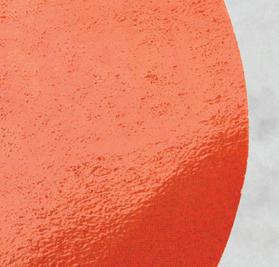

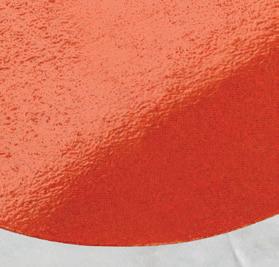






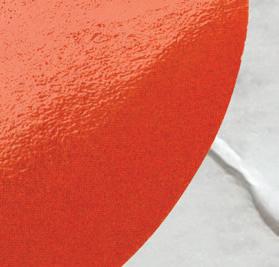
















































 editor-in-Chief Yasmeen Almomani explores the implications of trauma and
editor-in-Chief Yasmeen Almomani explores the implications of trauma and
As human beings, we go through life experiencing everything as a blur.
One of the fascinating parts of humanity is looking into how certain negative and traumatic experiences can impact someone’s health and their lives without their direct knowledge.
Although trauma is a nuanced and complicated word that can entail a wide range of definitions, there are three main types of trauma. Acute trauma refers to a single traumatic event that can be specifically defined with a beginning, middle and end. This can include assault or a car accident.
Chronic trauma is repeated exposure to multiple traumatic incidents, usually prolonged and ongoing abuse, for example, intimate partner violence or bullying.
Finally, complex trauma, which may be the most severe, refers to varied and multiple traumatic events with long-term emotional and physical symptoms. This can include prolonged neglect or experiencing homelessness.
The way everyone experiences trauma is highly varied and can span from no substantial impact to having a severe effect on someone’s well-being.
“The thing about trauma is it’s quite complex, so it really depends on how the person experiences it,” Kimberly Jewers-Dailley, contract teaching faculty in the department of social work and registered psychotherapist said.
“There is no set rule for how a person should react to a traumatic event… a traumatic event is an experience that should have never happened to anyone. The way that individuals or a community react to traumatic events can be completely different,” Abdelfettah Elkchirid, assistant professor in the faculty of social work explained.
Generally, trauma has a negative impact that can incline someone to adverse health effects.
“Trauma can have different effects, it can predispose someone for immediate or long-term mental health difficulties,” Amar Ghelani, instructor in the faculty of social work, and registered social worker said.
Despite the wide variety of impacts that trauma can have on someone who has experienced it, there is usually a change in the way one navigates through life and their quality of life following trauma.
“There are times you don’t even want to get out of the house, there are times all you want to do is sleep because you don’t want to face the world…,” Magnus Mfoafo-M’Carthy, associate professor at Laurier said. “It can be quite debilitating in the sense that you find yourself not able to engage in daily activities of living.”
The emotional challenges that can stem from trauma may cause someone to lose interest in their day-to-day life, including
mental health and interest in academic work -two factors that are relevant and important for students.
“[Trauma] can cause sleep disturbances, nightmares, hyper-reactivity, anxiety, depression, suicidal thoughts,” Ghelani said.
Furthermore, people can take up “unhealthy” coping mechanisms to endure the emotional turmoil that trauma has caused them and the toll it can take on mental health.
“Trauma affects our mental health in different ways; it changes the way we see life, and it sometimes forces us to [take up] unhealthy coping mechanisms,” Elkchirid said.
“It can make people want to do things that make them feel better in the short
“ abdelfettah elkChirid the faCulty ofterm, such as impulsive shopping or sexual behaviours, or substance use,” Ghelani said.
These maladaptive coping mechanisms, specifically substance use, are often viewed in a way that blames the person rather than considering what they have been through.
Jewers-Dailley explained that trauma-informed care, an approach that can be employed in therapy and treatment, takes away the blame aspect when helping those who have suffered through trauma.
“One of the staple phrases in trauma-informed care is viewing behaviour of others not as “what’s wrong with you?” … [but] seeing the behaviour and saying, what’s happened to you?” She said.
Trauma, much like biological features and characteristics, can be passed down through generations, which is known as intergenerational trauma. This term can be conceptualised in many ways, but Ghelani referred to it as people “inheriting traumatic experiences” from their parents.
trauma is the trans-
“Intergenerational
Trauma affects it is in our benefit mans to try stand its effects with it and also vent it from
and mental health in the community, with four educators and experts at Laurier.
mission of trauma across generations, we see this in groups who have experienced collective trauma,” Jewers-Dailley explained, referencing genocide and persecution as traumatic experiences that have happened to Indigenous People and those who have been unjustly enslaved.
“What we see is that the effects of the trauma are passed down to the generations, as previous generations are affected,” Jewers-Dailley said.
This process can happen in a number of ways.
“[It can happen] through [people’s] parenting styles, and passing on their trauma to their children, it could be by telling their stories to their children, leading to children being negatively impacted by their
He explained that stigma surrounding mental health and trauma can be a barrier to engaging people in a conversation about mental well-being.
Separate from the unfavourable effects of trauma, resilience and post-traumatic growth have both been documented as somewhat “positive” things that arise from traumatic experiences.
“For a small population, we see trauma actually having a positive effect on their life,’” Jewers-Dailley said, referring to post-traumatic growth.
“Some might say, ‘because of what I went through, I’m a better person for it, I’m a stronger person for it, I’m more committed to my faith, or I’m more committed to my family now, because of what happened,’” she said.
Similarly, resilience is known as adapting in the face of trauma or tragedy.
“The idea of resilience is building the inner strength to be able to cope, or to confront [trauma]… it’s really important to get knowledge and to get the necessary support, skills and the ability to be able to withstand things that come your way,” Mfoafo-M’Carthy said.
Elkchirid explained that this resilience is the capacity to face challenges and difficult situations.
Considering the wide range of reasons that trauma can occur, and the wide variety of ways that it can impact someone’s mental health, it is crucial to be able to recognize mental illness and how we can heal from it.
hirid, assistant professor in of soCial work
trauma,” Elkchirid said.

Mfoafo-M’Carthy also used an example of groups who were wrongfully marginalised and oppressed in the past.
“What happens is the impact of trauma on a first generation may impact the next generation… maybe the first generation that were abused, marginalised, oppressed etc. were not [displaying] the skills, the tools and the ability to deal with that trauma,” he said.
Certain groups may also still deal with experiences that caused trauma for their ancestors, such as racism or persecution for their identity.
The negative effects of trauma on mental well-being can be unintentionally ignored within communities that stray away from talking about mental health.
“In a lot of communities, when people realize that you have a mental illness, they tend to move away from you, because the illness is seen as a disability and there are negative connotation associated with it,” Mfoafo-M’Carthy explained.
“It’s about time we start looking at mental illness as part of an individual’s health because if it affects the brain, that means it’s also part of the body,” Mfoafo-M’Carthy said.
Furthermore, there are a lot of unknowns relating to mental health that need to be addressed for the betterment of our community.
“It is important for us to fund more research on the effects of trauma, not only from one individual to their children but also the effect of trauma on communities,” Elkchirid said.
“Trauma affects us all and it is in our benefit as humans to try and understand its effects and deal with it and also try to prevent it from happening,” he said.
The shared sentiment among educators and experts is that mental health is an important aspect of community well-being, and people who have experienced trauma deserve to be cared for.
Caring for others who have undergone trauma that has significantly influenced their mental health is for the best of these individuals on a micro level, and for the best of our community as a whole.
“
affects us all and benefit as huand undereffects and deal also try to prehappening.
Winter is a beautiful time of year. On our side of the world, natural and arti cial landmarks are adorned with a fresh blanket of snow and the streets are wiped clean by the onrush of new precipitation. e erceness and playfulness of the cold is complemented by the coziness of the indoors. In the midst of this, time seems to move a little slower and each moment is taken and absorbed to its fullest.
is elegance is accompanied by urries; urries of snow and urries of stress. As the semester comes to a close we are promised mountains of presentations, nal assignments and exams, all compressed into a neat cordillera of weeks. However, the anticipation of urries can sometimes be distracting.
We forget that this time of year is one of beauty. Beauty is not limited to the physical form but also extends to the emotional, including excitement and joy. In many cases, this excitement and joy is not rooted simply in the closing of the semester and the approaching leisure time, but in the upcoming celebrations. Across the farthest reaches of the planet one can nd people celebrating a diversity of holidays in the coming months.
Celebrations re ect the society they’re based in. Some have focus in religious beliefs whereas others draw on folklore or cultural beliefs. Christmas, for example, is a Christian holiday commemorating the birth of Jesus Christ.
Although Christianity is a widespread religion, di erent localities have di erent customs although, universally, it’s a time character-
ized by joy and thanksgiving, even in places where it has become a secular holiday.
Hanukkah, a Jewish holiday, commemorates the rededication of the Second Temple in Jerusalem and the miracle of the menorah. It’s celebrated over eight days through the recitation of prayers, exchange of gifts, preparation of traditional fried foods and the
lighting of the menorah.
Kwanzaa revolves around the celebration of Continental African and African American culture. It’s celebrated through music, dance, storytelling and traditional meals to re ect on the seven principles which exemplify the values of African culture.
Omisoka is a Japanese New Year’s Eve celebration in which
one prepares for the new year and welcomes good fortune. is is done by cleaning your home, having traditional meals with friends and family and visiting temples or shrines. In the modern age many have also adopted the custom of watching a national televised music competition.
Soyal is the winter solstice celebration of the Hopi peoples which includes prayer, dance, a feast and storytelling. Shab-e-Yalda, is an Iranian winter solstice festival which celebrates the triumph of good over evil.
On this day, Iranians recite traditional Persian poetry, eat Indigenous Persian fruits and tell stories.
e Day of the Covenant is a Bahá’í holy day which celebrates the appointment of ‘Abdu’l-Bahá as His father’s successor. It’s an occasion marked by joy, service and unity.
Outside of these wider cultural celebrations, there are more intimate a airs with friends and families who have their own unique customs. ese celebrations have a signi cance for these families.
Perhaps the signi cance lies in seeing loved ones who aren’t often seen, or in sharing a home cooked meal with neighbours. Maybe we see it in the services we o er for others, or in the learnings we share with our friends. Whatever it may be, the beauty of the holidays is universal.


mention the environmental toll, with post-holiday waste volumes in Canada growing by around 25 per cent from the end of November to New Year’s Day.
XUE LIFESTYLE EDITOR
If you ever want to experience true madness, just go shopping during the holiday season. Flocking through crowds in the mall, ghting over deals is nothing short of an Olympic sport.
Online shopping is also a frenzy, with occasions like Cyber Monday causing ash sales that have caused popular sites to crash. In the spirit of giving- and receiving, we are bombarded with calls to consumerism.
e average Canadian spent around $1,276 on holiday shopping in 2020. is year, economic uncertainty has led people to lower their holiday budgets, with 41 per cent of Canadians planning to only buy what their family needs.
During a season of rampant marketing, though, can we remember what we actually need? Many critics have bashed the commercialization of the holidays. Not to
Critics often believe the original meaning of the holidays will be lost in the sea of commercialization.
“You have to question what the original meaning was,” said Brad Davis, associate professor of marketing at Laurier University. “ at’s a bit of a fantasy, since a lot of these things were, to a very large extent, marketing inventions in the rst place.”
“In market-oriented societies, companies seize control of the cultural meaning of holidays and use them for commercial purposes. Marketing assigns meanings to the ritual behaviours around Christmas, like gift-giving.”
Seasonal marketing campaigns tend to promote nding the perfect present for loved ones. Popular campaigns include Apple’s “Make Someone’s Holiday” and Coca-Cola’s “Give Something Only You Can Give”.
“Holiday marketing creates pressure around not just buying presents, but buying the best ones.
Shopping has become part of this social fabric to de ne relationships in your life, to the point where there’s social consequences for not getting the right present,” said Davis.
While almost all industries participate in the frenzy of seasonal promotions, some generate more consumerism than others.
“ ere’s a disproportionate
amount of sales that happen before Christmas in the toy industry,” said Davis. “It’s also the biggest revenue period of the year for some electronics and appliances companies. ere’s much less volume for them during the rest of the year.”
However, holiday consumerism is also about aesthetics. After all, Canadians spent nearly $99 million on gift wrap and cards in December 2016, most of the wrapping for which ended up in the trash.
Charity involvement also grows during the holidays, with nonpro ts raising 17 to 31 per cent of their online revenues in December alone.
“We become conscious of how lucky we are to be shopping extravagantly. You know, if I can spend money on some ugly shirt for my uncle, I should fork over a few dollars for a good cause,” Davis said. at said, it’s important to not overlook the commitment that comes with certain causes. For instance, those who adopt from animal rescue groups for the purpose of a present during the holidays should remember it’s more than a Christmas gift.
NUR ELMASRI/ CORD PHOTOGRAPHY SADIYA TEEPLE/CORD PHOTOGRAPHY

Are you a Hallmark lover or a sucker for Christmas classics?
is holiday season, carefully craft your holiday movie bucket list to watch with your loved ones. Nothing says holiday spirit quite like a good lm that decks the halls and jingles all the way. Make some hot chocolate and snuggle up for this movie marathon list!
is year, Net ix brings a new Hallmark-style Christmas movie. You know the type; cheesy love stories with a predictable ending, but are lighthearted and warm your heart regardless.
“Falling for Christmas” is a new holiday movie with Lindsay Lohan. Her character goes on a ski trip during Christmas, bumps her head on the ski hill and forgets everything about herself. Rather than nding her way back to her

husband, she nds her way into a family ski lodge owned by a single father. If you can’t already tell where this is going, you’ll have to nd out for yourself!
Next on the list is a musical you can’t miss with some Hollywood favourites; Will Ferrell and Ryan Reynolds, called “Spirited”. is comical twist to Charles Dickens “A Christmas Carol” story might just be added to your Christmas Classic list. For now, you can
stream “Spirited” on Apple TV+.
If you love Will Ferrell’s sense of humour, you’ll love watching Elf even if it’s your 10th viewing! Nothing says Christmas like a big man in an Elf costume who thinks he’s an actual elf and nothing says Will Ferrell more than this movie. You can watch “Elf” on HBO or purchase it to watch on Amazon Prime.
Don’t forget about the true Holiday classic lms, the childhood
favourites that even your family has grown to love. Our list includes the original Home Alone series with Macauley Culkin; “Home Alone” and “Home Alone 2: Lost in New York”.
Of course, you could go on to watch the 3rd, 4th, 5th, and 6th Home Alone movies, but they may not give you the same sentimental feeling the originals do. All the Home Alone movies can be found on Disney Plus.
“ e Grinch” is another holiday must-watch. How many times do you think you’ve watched this movie in your life? You really can’t overdo it with this one! If you haven’t yet seen the 2018 iteration of “ e Grinch”, the music and comedy make it worth a watch!
If you haven’t seen “ e Santa Clause” chronicles, do not walk, run to Disney Plus to watch them. is trilogy consists of the original “ e Santa Clause”, “ e Santa Clause 2”, and “Santa Clause 3: e Escape Clause”. e best of Christmas magic is seen in this series.
Some last, but not least lms to add to your holiday movie bucket list, are “Christmas With e Kranks” on Net ix, “ e Polar Bear Express” on Apple TV, “Miracle on 34th Street” on Disney+ and “National Lampoon’s Christmas Vacation” on Net ix. Happy viewing!

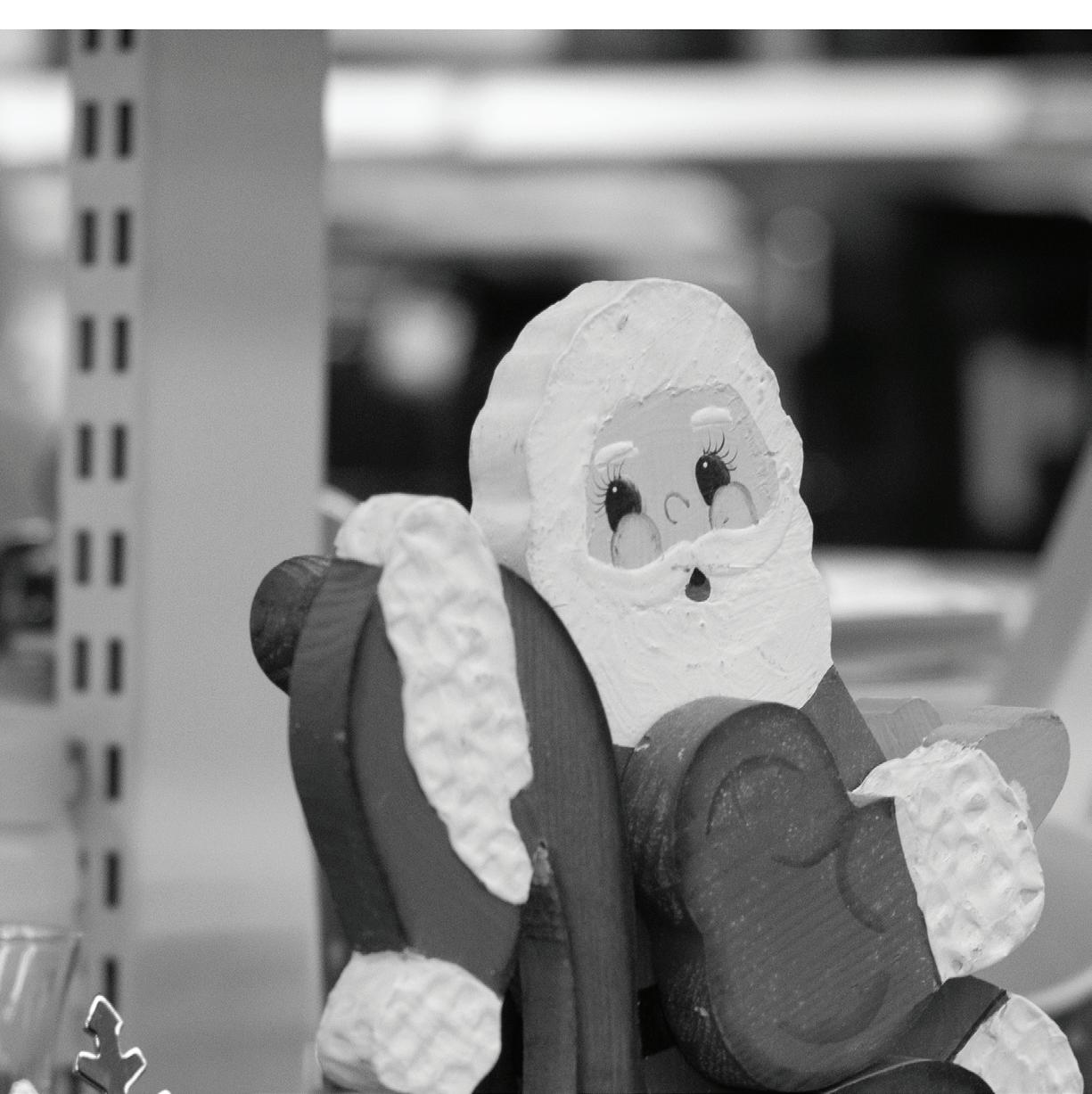 AMNA ALI ARFAN LIFESTYLE CONTRIBUTOR
AMNA ALI ARFAN LIFESTYLE CONTRIBUTOR

e realization that Santa was merely a ctional character crafted out of century old legends and consumerism is a realization everyone inevitably reaches during their adolescence. Speaking from personal experience, I had discovered that the jolly old fellow was not real when I was 12, to my great disappointment.

No longer did my heart race at the sight of the “From Santa” tag written over my presents. Instead, I would wake up on Christmas morning and know that all the presents under the Christmas tree had in fact not come from a factory, wrapped up by special elves and whisked away on a sleigh led by Rudolph.
By not believing in Santa, I had also stopped believing in the magic of Christmas.
Not believing in a ctional character was understandable.


What had been hard to grasp was why exactly I stopped believing in Santa. Growing up, I had persisted against my siblings’ teasing me for believing in him, as well as my peers who gloated in being mature enough to realize the truth.
e fact that there was someone whose only goal was ful lling the wants of children around the world through gifts, in exchange for only cookies and milk, had excited my young mind. So, what exactly had spoiled my belief of the jolly old St. Nick?
Truthfully, I believe it was when I understood the real meaning behind Christmas, that I came to terms with Santa not being real. Having learned to appreciate the time spent with family and friends, as well as the spiritual aspect of Christmas, I acquired a more positive outlook on Christmas.
Gradually, I reconciled with Santa not being real, as I had been able to have a more enlightening perspective on Christmas. Of course,
one could also say the insistent teasing from my peers had nally gotten to me.

Upon re ection, I’ve realized that not believing in Santa has not hindered me. Not falling into the enchantment of Christmas had been outweighed by my new view on Christmas. Rather than anticipating the 25th of December for the gifts that awaited me, I was able to cherish the full month for what it gave: A moment to celebrate with loved ones.
Moreover, I was also able to begin gift giving. While it did become a strain on my wallet, it also allowed me to give back to close ones, as well as others in my community, making it well worth the expense.
Even though I have continued to leave milk and cookies by the replace, I now wake up on Christmas day looking forward to time spent with loved ones, as well as giving what I can to others.

 ABRAHAM ARTS EDITOR
ABRAHAM ARTS EDITOR
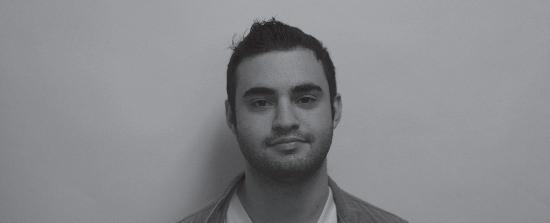
Gift-giving time is upon us, and you know what that means; Pure unadulterated panic as you scramble to get a gift for loved ones! Well, fear not, I have three quality suggestions for holiday gifts your friends and family will enjoy!
I remember in the olden days when I’d flip on the TV and enviously watch commercials for the Snuggie. With no allowance money and my parents being under the false impression that I already had enough blankets (you can never have too much) I was left ‘snuggieless.’
Thankfully, now I’m an adult and not only can I live my childhood dream of being a sleeved blanket owner, but I can share this gift from the Gods with my loved ones as well. In the modern age comfortability reigns supreme so why not go all in when it comes to snuggling up and getting cozy?
The combination of blanket
and sweater might be the most perfect duo since Santa Claus and reindeer. If you gift someone a sleeveless blanket you can be assured that they’ll never have to be cold again during the frigid holiday season.
Many care for bugs and have no angst when they find one in their living quarters. If they see a spider crawling around their walls, they can delicately collect it and place it outside. The rest of us, however, would sooner consider burning our whole house down. I have found a unique solution for those who can’t stand pests.
BUG-A-SALT is a gun that shoots salt. Available in multiple colors as well as being able to utilize common cooking salt as ammunition, the BUG-A-SALT packs a powerful blast capable of dispatching even the most fearsome of tiny critters.
Further, you can shoot at other objects, including targets that come with the ‘weapon.’ Make sure you don’t aim it at one of your friends, though, even if they’re BUGGING you.
Cold hard cash
Look, I know it’s controversial, but it needs to be said. Society has taught us that when it comes to gift giving, it’s the thought that counts,
not the price tag. I’m advocating for you to take that and throw it in the trash.
Gifts are always meaningful, especially when the person giving them puts in the effort. However,
sometimes you have no idea what to get someone, and you wish you had just gotten the money that was spent on a gift instead.
People like money an awful lot, so I see no reason why giving
money as a gift should be taboo. Save yourself the stress and the potential for gifting failure; just hand over some cash.
I was thrilled to watch the movie premiere of Project Iceman, a film which surpassed my expectations and is perfect for inspiring people to follow their dreams, no matter how unrealistic they may be.
I was very inspired watching this movie and hope to inspire others by recommending it.
Project Iceman is a documentary about an ordinary man (Anders Hofman) from Denmark who graduated business school with good grades and got a job as a management consultant - a seemingly perfectly ordinary path for one to follow.
However, that wasn’t enough for Hofman. He chose to change his life around and do something else.
In 2018, he came up with the idea to complete a triathlon in Antarctica that he named Project Iceman. He made a video declaring that in 2019 he would swim 3.8 kilometers in ice water, bike 180 kilometers and run a marathon in Antarctica.

He naturally faced opinions from the public, who told him the idea was impossible and that he would not be able to swim in ice water, which showcased the associated risks with his idea.
The movie portrays how, as a kid, Hofman dreamed of becoming a professional footballer but was told that he was not good enough. He gave up on that dream because of what people led him to believe.
However, in 2019, he turned the criticism he faced into a message: “Limitations are Perceptions!”
What we can or cannot achieve are either our own or other’s perceptions, not reality. None of us know what our limits are until we actually try doing it.
As such, Hofman started training for the iceman. The first time he jumped in ice water, he could only stay for 30 seconds. After a week, he was able to hold for 11 minutes.
He kept training while also man-
aging financial side of the project. He was so devoted to this idea that after being rejected by sponsors, he took a loan of $100,000 to pursue this dream.
Another important part of his story is how Hofman’s movie came to life!
Hoffman was also discovered by “Yes Theory”, an organization based in Los Angeles with the mot-
to, “Life’s greatest moments and deepest connections exist outside of your comfort zone.” Starting out in a small apartment in Montreal, Yes Theory was able to inspire millions of people to chase their seemingly unrealistic dreams only seven years later.
Yes Theory came across Anders Hofman in 2019, and were inspired by his insane dedication. Choosing
to support his journey, they decided to fund his project and send a film crew to film him.
Hofman and his team completed the Iceman in 2020, and gave the community a chance to become partners for the movie. Later on, they premiered the film in eight different cities around the globe.
Hofman faced many obstacles during the process: Adequate financials, rigorous training and a knee injury.
Despite this, he completed his expedition and achieved what everyone thought was impossible. He frequently mentioned in his videos that despite his team being so inexperienced, together they accomplished so much.
After watching the film, I was astounded at how well it captured the alignment that can happen when you are dedicated to a cause. If you have a crazy idea that you deeply care about, you will find people who are like-minded and will help you get to that finish line!
The biggest takeaway from this movie was to ask yourself what your own Iceman is. Put it out there in the world, work towards it and there will be a time when you will witness your dream become a reality.
At the end of the day, we are all just that kid who is either living their dream or wishing that they would be living their dream.
 KAYANNA THOMPSON LIFESTYLE CONTRIBUTOR
KAYANNA THOMPSON LIFESTYLE CONTRIBUTOR
Whether you’re looking to build a new personal style for 2023, out of the loop with the latest fashion fads or just downright curious, you’re de nitely in the right place.
Fashion designer Stefano Gabanna once said, “Fashion takes its inspiration from society and everyday life, which is the same for everyone and this, is perhaps the reason why certain elements recur.”
Given the butter y e ects of the coronavirus pandemic, what does this mean for next year’s trends in fashion?
Presumably, you can anticipate many o beat variations, from modern ensembles with nostalgic airs to a new generation of clothing design.
Get the intel on what’s hot or not with our predictions for emerging fashion trends of this coming year!
1)
e overlapping of fashion subcultures truly captures the latent end-of-the-world hysteria that is accompanied by a disarrayed unravelling of social norms and structures.
For example, ‘Soft goth’ has emerged as heavy black clothing takes a lighter form and plays with transparency, ru ed patterns and lace.
Meanwhile, the ‘city school girl’ look includes plaid skirts and bows paired with grunge street style, using mesh layering and lug sole shoes.
2) Denim is coming year, denim gets a face-lift. Baggy high-waisted jeans make their way into 2023 as fall runways showcase multi-layers of denim clothing.
Recycled denim also gets a glowup as lighter and darker shades are patched together with distressed stitching, giving Canadian tuxedos a whole new vibe.
Expect a ourish of oral prints in shades of red and pink on dresses and blouses.
Alternatively, some designers will take it a step further, sewing 3D owers onto solid-coloured apparel, adding an element of pop!
Oversized low-rise trousers and cargo pants make their mark this coming year. Completed with an assortment of deep pockets. is o ers style, comfort and compensation for the surge of mini bags over the last few years. Finally, something that ts your wallet, keys and phone!
Fashion o ers a love letter to earth’s natural beauty in 2023. Dresses, tops and everything in between.
Using fabrics with bright hues that are blended together and imitate watercolour paintings of orange gradient sunsets.
At the same time, other pieces mimic ocean blue shades.
All and all, by the words of designer Coco Chanel, “Black has it all. White too. eir beauty is absolute.”
NUR ELMASRI/ CORD PHOTOGRAPHYBlack is timeless no matter the cut; you can’t go wrong with an allblack ensemble or your favourite white tee paired with classic blue jeans.

o’clock news program with a rendition of Silent Night.
Bridgers’ cover features her and Fiona Apple singing the tune.
JACKSON WELLS STATION MANAGER, RLIt’s hard to go anywhere in December without hearing Christmas music. On the radio, at your parent’s house, even walking through the grocery store- it’s inescapable.
ere’s a rich history of popular Christmas songs that persist even decades later.
e great classics of Bing Crosby, Nat King Cole and Darlene Love harken back to Christmases during which most of us yet to be born.
Modern classics from Mariah Carey (the Queen of Christmas), John Legend, and Michael Bublé remind us there’s still some gold to be mined from the Christmas music mountain.
Now that we’ve got that sentimentality out of the way, listening to the same classics every year can be tiring.
If you want to spice up your Christmas gatherings this year, spin these tracks and see how long it takes for someone to complain.
1) Carol of the Bells by August Burns Red
Everyone loves the classics. What everyone might not love is a metal-core cover of a traditional Ukrainian Christmas carol.
In their cover, August Burns Red presents a familiar rendition of that
classic tune.
It has signi cantly more electric guitar breakdowns and double kick pedal drum solos. is track will be sure to have someone yelling “Turn that noise o !”.
2) It’s Christmas and I Fucking Miss You by Charly Bliss & PUP Christmas 2020 was not a great time for most of us due to lockdowns and travel restrictions.
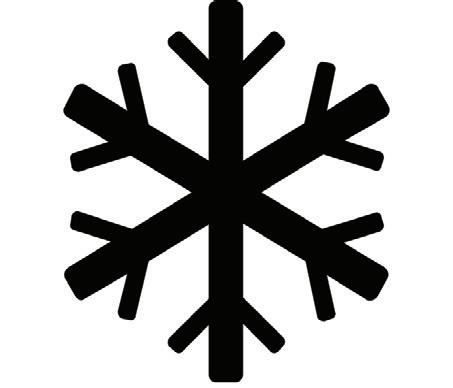


It was nearly impossible to spend time with family and loved
ones. However, Christmas brings out those lonely and longing emotions without a global pandemic.
ere’s a whole genre of sad Christmas songs about the melancholy of the season.
Luckily, Charly Bliss and PUP were there to bottle up those extrapandemic holiday emotions in a surprisingly not angry song about not being able to see your partner during the holidays.
Unfortunately, they swear a
whole bunch while doing it! So it might not be a crowd pleaser for the whole family.
3) 7 O’Clock News/Silent Night by Phoebe Bridgers feat. Fiona Apple & Matt Berninger
Indie rock star Phoebe Bridgers has released a Christmas cover every year, nding more obscure songs each time.
In 2019, she released a cover of Simon & Garfunkel’s sound collage, combining a simulation 7
Meanwhile, Matt Berninger of e National presents a news bulletin of topics such as the opioid crisis, restrictive abortion laws, and the [ rst] impeachment of Donald Trump.
While heavy metal and swearing may scare your grandparents, nothing will really suck the mood out of the holidays like gearing up for some family political discourse.
4) Rudolph the Red-Nosed Reindeer by DMX e story of the late DMX’s rendition of Rudolph the Red-Nosed Reindeer is a long and celebrated one.


It was orignally improvised at an interviewer’s request in 2012.

It took until 2017 for an o cial version to be released through a Spotify Christmas music compilation. Even so, it wasn’t released elsewhere until after his death in 2021.
DMX’s gru voice and persona seem like the opposite of what you’d expect on the song.
It is most notably sung by country star Gene Autry and Burl Ives for the Rankin-Bass animated lm.
But DMX’s infectious enthusiasm and exciting production twist on the tune make you want to get up and sing with him.
Your family might disagree, though.
 JACK O’KEEFFE ARTS CONTRIBUTOR
JACK O’KEEFFE ARTS CONTRIBUTOR
It’s been getting cold, dark, and snowy and Christmas music has taken over the airwaves. With the passing of American anksgiving, seasonal commercials replace their predecessors.
As the temperatures drop, Charlie Brown’s seasonal depression kicks in following the consumerist culture that comes with the season- it’s Christmastime!




After it began in 1965, he brie y danced with the capitalistic devil in the shoddy 1992 sequel.
However, his revelation of consumerism’s precedence over the holidays gets more pertinent each year.
When we’re kids, Christmas and the ensuing presents are enough to o set the dropping temperatures. But as we grow older, this rosy view of the holidays begins to fade.
e commercials on TV show happy families gathered around the re, signing merry tunes and the songs played on the radio all echo the same themes of joy and cheer.
It’s easy to feel alienated in this seasonal environment where any reminiscence of reality is replaced with the plasticity ctitiousness of
the holidays.
Even Charlie Brown is aware of this, picking the only real tree - a short, crooked, and shedding evergreen - instead of the plastic imitations.
Charlie’s depression isn’t so much an e ect of the snow, but of

the consumerism of Christmas. Everywhere he turns and everyone he knows seems to inherently link the holidays with getting rather than giving.
Worsening his condition, Charlie feels left out of Christmas celebrations, receiving no holiday
cards - and he’s not alone.
Mood has been found to worsen during the holidays along with feelings of general dysphoria and the use of psychiatric services decline.
Charlie seeks such services but nds little solace in Lucy’s capital-
istic approach to therapy.
Su ering under the invisible hand of Christmas’ consumerism, Charlie works as the antithesis to Dickens’ Ebenezer Scrooge.
While Scrooge discards the non-materialistic bene ts of the holidays, such as getting together with family, he holds a much greater value in increasing his capital.

Charlie wishes for holidays scrapped of material gain, xating on the emotional and familial roots of the holiday.
He tries in vain to direct the Christmas play, which is hindered by his disappointment at the state of the holidays. is is backdropped with the Vince Guaraldi Trio’s nostalgic jazz.
Charlie urges viewers to do away with the material values by which Christmas has become intertwined with (as they once did in Whoville).
He also encourages viewers to note the constant pressure to consume associated with the holidays and to treat Christmas as “a kind, forgiving, charitable, pleasant time.”





is tone rings truer with each passing year, as spending on forthcoming holidays, including the recently passed anksgiving, reaches all-time highs.
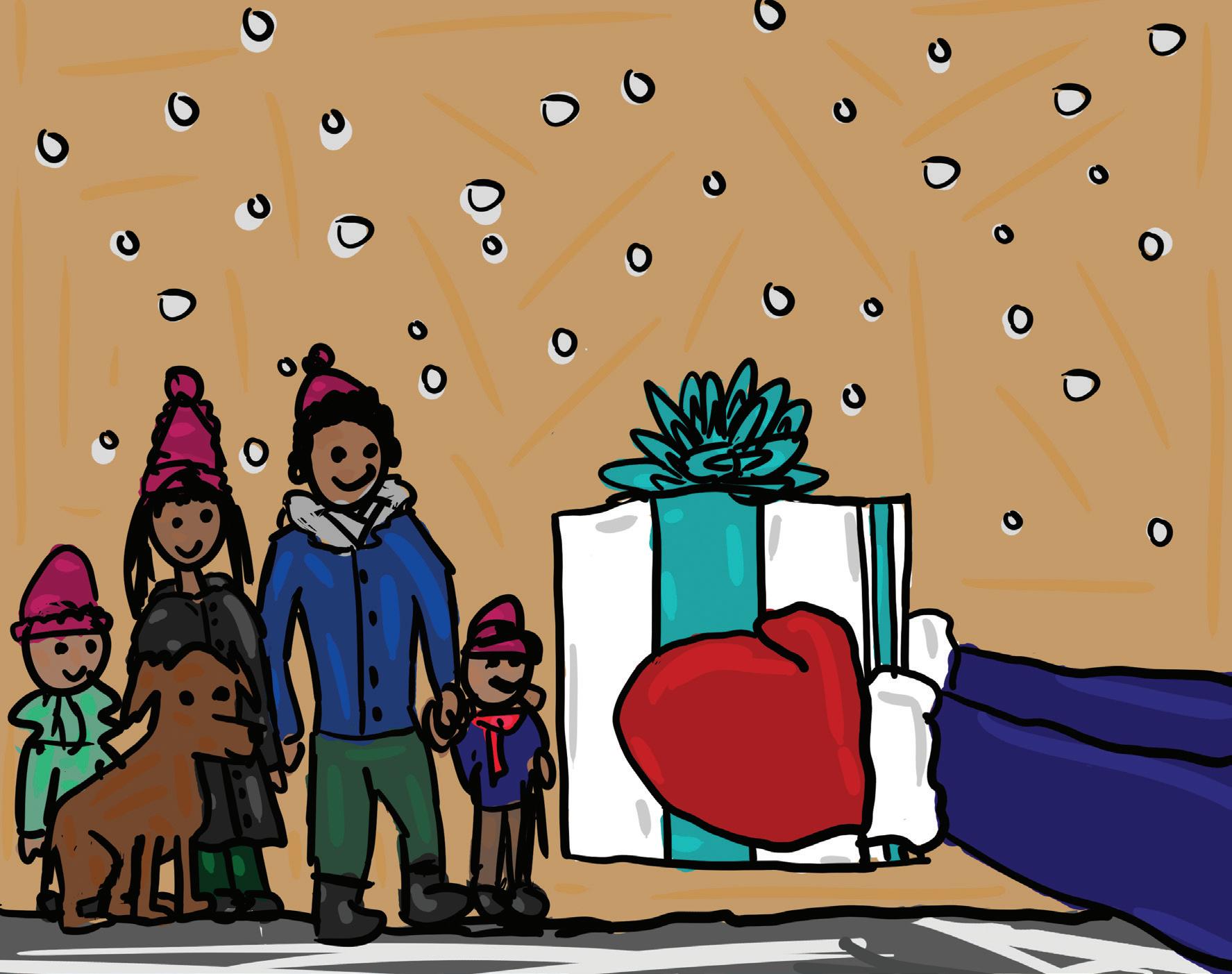

No matter how bad you are at acting, you’ve probably pulled a Leonardo DiCaprio at least once in your life if you’ve ever received a gift you didn’t like. When you’re holiday shopping this season, it can help to remember that the best gift for someone comes down to their love language.
First created by counselor and author Gary Chapman, the ve love languages is a concept that describes how we want others to show us love and how we show love to others. It’s been supported by multiple academic research studies.
Here’s how to shop for the people in your life with di erent love languages!

For those who value verbal connection, the best gift is an expressive one. ey like to hear or read what you appreciate about them.
Classic ideas include; an annotated copy of their favourite book with your notes in the margins or a memories jar lled with your best moments together.
Some feel most loved when others lend a helping hand or show
a kind gesture. While it may be an unconventional gift, you can help a loved one complete a task they’ve been struggling with.
A creative gift is a book of coupons with di erent favours on them that they can use when they need your help. Whether it’s house
cleaning, gardening or TV xing, they’ll be honoured you paid attention to their needs.
Another idea is a home-cooked meal or planned trip for you and your partner, friend or family member. By taking care of the planning and details, you’ll show
your care and consideration.
While people with this love language may seem like the easiest to shop for, that isn’t always the case. e best gift shows you know them and put thought into it. For instance, a subscription
box for their favourite chocolates is better than a box of whatever candy you see rst at the store. Similarly, a gift card to their go-to co ee shop is more personal than a gift card to a random co ee place.
Some prefer to be shown love by spending time with loved ones. Having your undivided attention means a lot to them.
An ideal gift is tickets to attend an event together that they’ll enjoy, whether it’s a concert, holiday lights show, or any of the activities Kitchener-Waterloo o ers.
Remember to make it a distraction-free time so give your phone minimal attention.
ere are actually many meaningful gifts you can get for someone whose love language is physical touch. From matching friendship bracelets to a necklace or watch for your partner, they’ll appreciate a gift that reminds them of you even when you’re apart.
To take it a step further, you can get a custom-made piece to make it special to your connection. Clothing works as well, especially cozy pieces for winter.
Remember that love comes in many forms this holiday season, all of which are meaningful!


considering how real and valid the topics we learn in university are.




is time of the year, although associated with joy and celebration in times of holiday, can also come with something we are all quite familiar with: burnout.
I remember there were times as a student when I would be so strung out at this point in the semester that it seemed incapable to write even 200 words, let alone a paper or an exam in the Athletic Complex on a Saturday night.
Furthermore, some of the content we consume as students can be very draining and hard to process.
Some papers reference war, violence, or pain in a way that is tough for humans to process quickly then move onto the next task, especially if these topics trigger some form of feelings for someone.
ese feelings are real and valid,
As someone previously health sciences major, there were times were I was constantly reading up on stress and health inequalities.
ese are also things I do in my free time, so there were times where I had to take a step back from my academics and just take a break.
Even topics like organic chemistry and calculus can be draining to consume and learn about every second of the day.
e moral of this editor’s note is that it is okay to feel exhausted from the stu you study on a content basis.

is level of burnout can make it even harder for someone to write an exam or a paper e ectively with a brain so full of information and knowledge.
As exams approach, remember to let yourself take a break from constant knowledge consumption and studying!


exactly what you want to do by the age of 14. Let’s just…stop.
I know, easier said than done.
At some point I’m sure we’ve all felt like we are on a conveyor belt, an endless assembly line of students.
jority of that former guilt was gone. Finally becoming adjusted to my last year which comes with many more expectations and deadlines, I’ve stepped back almost entirely from clubs to focus on my studies.
e minute you begin your rst year at university, there are a number of expectations (both spoken and unspoken) that you are supposed to ful ll. By the end of rst year, for a number of programs, you may feel like a failure if you have not come out with a great internship for the summer.
Following this, you should (of course), have an even better summer job every other year of your university career.
Furthermore, you should have the perfect LinkedIn pro le, work on at least ve side projects related to your degree and begin to think about what you’ll do after university. You can’t possibly take a moment to think or reassess your life, of course.
You’ve been told ever since grade nine - you need to know
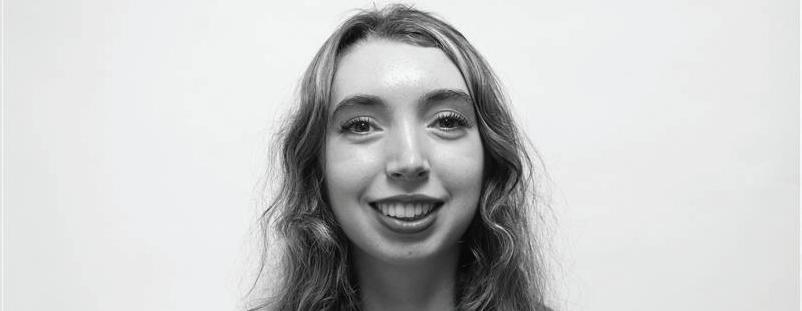
We might not be conscious of it, but it’s an easy cycle to get into.
Now in my last year at Laurier (in an arts program), I’ve felt some more clarity on how university is full of as many milestones as highschool is. However, they’re far sneakier. Especially if you also have the (apparent) disadvantage of graduating with an arts degree.
e main one is being unaware of just how fast the semesters move, and how many resources there are at the university that you will simply never have enough time to take advantage of.
In rst year, I felt a lot of guilt for not being able to take part in every club I wanted to. It was hard to strike up a healthy balance.
In my second and third year, I had managed to gure out a system to keep everything on track.

I was overworked, but the ma-
I’ve felt more disconnected from the university, only coming to attend classes and the occasional event with friends.


Guess what? at’s okay. Don’t put pressure on yourself to hit milestones in your university career as you make your way through.
Don’t feel guilty as the years go on and you feel more disconnected from the whole “university experience.”
As we graduate and move on from our lives, we have to learn how to be generous and gentle with ourselves. As soon as you think that you’re completely free from milestones (such as when you graduate), they will only be replaced by new “adult” milestones.
We all grow at our own pace. Embrace your unique lived experience and follow your own inner path.
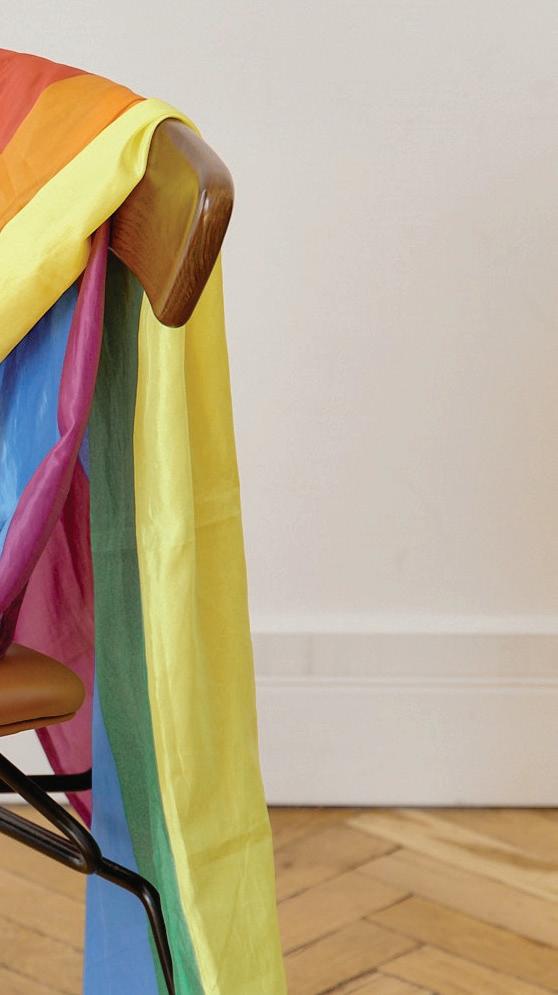
 NATASHA SHANTZ OPINION INTERN
NATASHA SHANTZ OPINION INTERN


Content warning: this article mentions violence.

I feel gutted every time I hear about another shooting, and yet, horribly, it shouldn’t come as a surprise.
e Nov. 19 attack on the Colorado venue Club Q, where the shooter killed ve people, is just one of many fresh wounds from which the LGBTQ+ community is hurting.


In Manhattan on Nov. 24, a man was charged after breaking the window of a gay bar repeatedly, an o ense that indeed hits too close to home considering the incidents in Colorado.
Let us not forget the 2016 gay club shooting in Orlando, Florida that killed 49 people, in what was the deadliest mass shooting by a single gunman in U.S. history, at least until the following year.
And yet, we already have forgotten it, a habit that is too common for most of the global public.
But I will not let myself gloss over this hate crime with the typical narratives.
It is not enough to merely respond, “we are deeply saddened, gun violence should stop”; gun control is one of the most dire needs in relation to these attacks, but repeating this necessity without action will get us nowhere.
And on the part of the rightwing, it is not only counterproductive, but deeply wrong, to blame the queer community for the
persistence of mass shootings.
ese horri c instances require a deeper look into the ideologies that fuel such violent rage, and that night in Colorado especially stands out to me as a glaring example of ingrained hatred, both of the self and of others.

e shooter, a 22-year old local named Anderson Aldrich, identi es as non-binary, using they/ them pronouns, according to their public defenders.
eir father, Aaron Brink, a mixed martial arts coach and a former adult lm actor, was interviewed by CBS 8 several days after the attack.
As he describes, his initial reaction to the shooting was concern that his child was gay, not that they had become a mass murderer.
As he describes, his inital reaction to the shooting was concern that his child was gay, not that they had
-Natasha Shantz, Opinion InternAs Brink then elaborates, “I’m a Mormon, I’m a conservative Republican, and we don’t do gay”.
He later clari es that he is sympathetic to the victims’ families.
However, it is no coincidence that Aldrich was led down such a dark path.
Hate fuels hate, in many forms.
In the Church of Jesus of Latter-day Saints (Mormon church), it is taught that homosexuality itself is not a sin, but acting on it is.
And although the Respect for Marriage Act, which would protect same-sex marriage in the United States, was advanced into federal law on Nov. 16 with a vote of 62-
37, only 12 out of 49 Republicans voted for the bill.
ere are few public biographical details about Anderson Aldrich. However, considering the facts of their family and the ideologies they would have grown up with, I would assume that the shooting carried out that Saturday night was a direct result of ingrained hatred against the LGBTQ+ community, and very likely, a potent form of self-hatred too.
Aldrich’s own identity may have been a cause of much inner turmoil, but it is also no excuse for the deaths they have caused.
But either way, it needs to be emphasized that youth are especially susceptible to the opinions of those around them; if they hear their parents repeat phrases of prejudice and intolerance, either to them or to others, it has a lasting impact.
Hate is taught, and we need to be more aware of this in order to prevent it.
At best, kids taught to hate will be forced to form their own, di ering beliefs after some struggle.
At worst, they will act on their beliefs and consequently commit murder.
So let’s not move on so quickly. We need to mourn the victims of the Nov. 19 shooting, the continued lack of a society that should have better understood their vulnerabilities as part of a minority group, and more importantly, we need to actually talk about it.
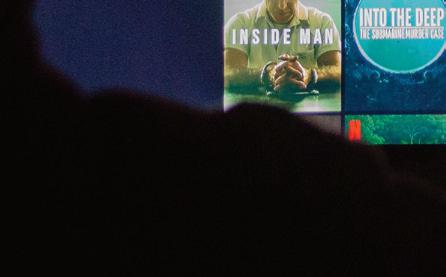 AMAN KHAN OPINION CONTRIBUTER
AMAN KHAN OPINION CONTRIBUTER
Everyone has their guilty pleasures, shows or movies they like to watch to unwind.
For me, and for many others, those shows are crime dramas and police procedural programs like ‘Criminal Minds’, or ‘Castle’.
Shows like these are accepted forms of entertainment for people all over the world, but what we do not realize is just how signi cant their impact can be on public perception of crime and the criminal justice system.
Crime dramas, documentary style programming, daytime television shows; these are all sources of infotainment.

ey are made to inform viewers but are also portrayed in a certain way to provide entertainment.
e ‘entertainment’ aspect of these shows usually consists of an inaccurate representation of violent crime and the way law enforcement works.
All this, while greatly entertaining, even for me, can have such an impact on the way we understand crime and how it is dealt with.
Such programs often misrepresent the level of violence that occurs.
Further, they frequently show an inaccurate portrayal of law enforcement, and the lengths they go to, to catch the ‘bad guy’.
e o enders are mostly depicted as psychotic and extremely violent.

Each crime they commit is unnecessarily brutal, and at the end
of each case, there is almost always a ‘happy ending’.
ese dramatized representations of crime can distort the public’s perception and lead to them forming unrealistic expectations.
By generalizing such violent behavior, it can promote stereotypes and biases and lead them to making assumptions about criminality.
e amount of cruelty and violence that is shown can desensitize viewers and can in some cases, even trigger aggression.
e main basis of the crime might be factual, but these shows use several di erent techniques to

enhance them.
ey use ‘ ctionalized recreations’, to draw in and entertain the viewer.
By analyzing criminal acts and o enders in these shows, viewers are given interpretations on how to understand them.

is unrealistic representation, along with our individual fear of crime and being victimized, can cause us to reach dangerous and unfair conclusions.
When it comes to crime, individuals do not completely base their perceptions o what they directly experience.
Instead, they are in uenced and base it o of what they see and hear in the media.
Media holds power over public conceptions.
Such exaggerated depictions of crime and the criminal justice system can a ect their sense of reality.
ey can also warp and blur
PHOTOGRAPHYthe lines between what is real, and what they think is real.
Our entire understanding of crime and attitude towards the criminal justice system can be in uenced by these programs and the inaccurate way they portray crime stories.
As much as we consider these programs to be quality television, we should be aware of the impact they can have on our understanding of the world we live in.




 O’KEEFFE OPINION CONTRIBUTOR
O’KEEFFE OPINION CONTRIBUTOR

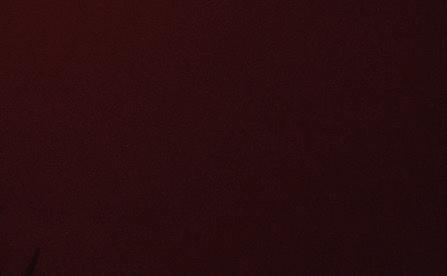

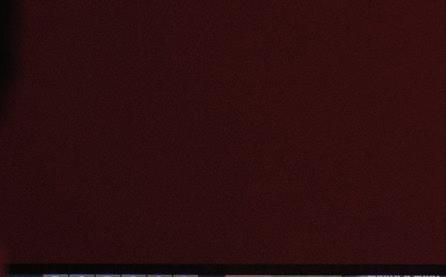
I must simultaneously commend and condemn the actions of the youth united around the world.
rough vandalism and disruption, they have brought themselves to the forefront of western media with cans of soup, paint, and glue.
Groups like XR, the A22 Network and, most notably, Just Stop Oil are a handful of the groups who support.
ey do this by supporting each other through the “encouragement” (in the words of A22), ‘mass civil disobedience’ in an attempt to spark change in all forefronts of the government, but chie y regarding climate change.
ese acts of ‘civil disobedience’ vary greatly.
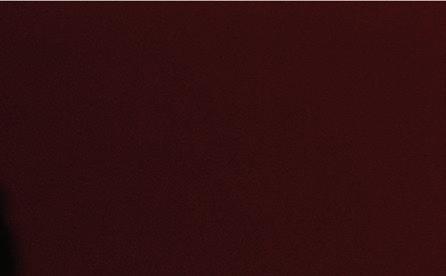
is includes gluing themselves to streets to disrupt tra c, hunger strikes, covering banks in paint and throwing food at paintings. However, in the majority of the cases the art remained undamaged, the message was clear.
Change is not only wanted, but needed immediately.
If you’re quick to judge, these acts would not only seem meaningless in achieving their goal, but you’d regard this attempt of protest as childish.
is is something that I agree with in many aspects.
If groups like Just Stop Oil can gain and rally so many supporters, I’m sure that they could nd a way to run for parliament.
Instead, they promote civil unrest through destroying art.
ese protestors, the majority being teenagers and young adults, look away from their parliamentary system when regarding e ective change.
If you listen to any of the speeches made by these protestors, you’ll see that these young people are driven by anxiety of the impending doom of global warming that they will su er within their lives.
How many times have protestors been criticized for not attempting change, rather just posting about what they’d like to happen?
Even if these groups are not focusing their productivity in the right areas, they’re being productive, nonetheless.
ese groups alone have gathered more headlines and tweets than one can count.
As time goes on, they only continue to garner more members.
Many will laugh at these acts of insolence, yet they are defending the same planet on which we live upon.
rough their actions they have pointed out that we need change to continue inhabiting Earth, yet we remain unconvinced.
In similar vain to Nietzsche’s madman, although the protestors are attempting to preserve our planet for future generations and have our best interests in mind, we look at them disconcertedly.
Many people remain uncon-
vinced that change must be taken until it’s too late and the metaphorical ‘lightning and thunder’ is upon us.


We then realize that we brought the end upon ourselves.
Despite the visible manifestations of our impending climate catastrophize, Earth has not become inhabitable, or even uncomfortable enough to inspire change.

Governments see little incentive for change although scientists have incontrovertibly sustained the opinion that action must be taken as soon as possible.
Acting in classical capitalist fashion, corporations and governments have taken a form of Freudian death drive upon themselves; seeing how close oneself can get to the ame before burning.
In the eyes of these protestors attempting to protect our planet, it seems like an unwinnable battle.
To quote Upton Sinclair: ‘It is di cult to get a man to understand something, when his salary depends on his not understanding it.’ When examining the focus points of these various groups engaging in ‘civil disobedience,’ it’s hard not to acknowledge the Marxist in uences.
is includes standing against poverty, corporate greed, and criminal governments.
Many will laugh at these acts of insolence, yet they are defending the same planet on which we live on.
-Jack O’kee e, Opinion Contributer
As separate and isolated entities, they realize they stand no chance in making a change, yet together they have a ghting chance.
With such a banal ending, it’s hard for one to avoid reminiscing upon the nal lines of Marx and Engel’s Communist Manifesto: ‘ e proletarians have nothing to lose but their chains. ey have a world to win.’
The ‘entertainment’ aspect of these shows usually consists of an inaccurate representation of violent crime and the way law enforcement works.
-Aman Khan, Opinion Contributer
him along the way: Coach Peter Campbell.
Campbell had previously coached at Laurentian during Falco’s days as a student-athlete.
NATASHA GIANNANTONIO SPORTS EDITOR
Entering his 15th season coaching the women’s basketball team, Coach Paul Falco has had nothing short of an impressive career, both on the sidelines and on the court.

“I was still more of an assist guy, and then a points guy. I was usually looking to make plays for my teammates … We had some really good shooters … I could just try and nd them.” Falco said, reminiscing about his time playing at Laurentian.
His points skyrocketed from his second to third season, going from 21 points in 12 games to 71 points in the same time frame, ending his career on a rampage, tallying 130 points.
Still, Falco emphasized his playmaking ability and sight on the court, keeping his scoring humble.
“I don’t even think they tracked the assists back then.” Unfortunately they did not, but Falco’s name would no doubt be among the top.
Coach Falco joined the Hawks organization in 2000 as an assistant coach for the men’s basketball team, where he would help lead the team to the CIS Final 10.
A familiar face helped guide

 WORLD CUP
WORLD CUP

Campbell spent 15 years as the head of the program before joining the Laurier men’s squad in 2000, where both coaches were new to the Golden Hawk environment.
“ ere’s probably 101 things that I’ve learned from him … in terms of how to put a team together and what characteristics are important when you’re recruiting players. He put a lot of emphasis on bringing people who are really good team people and team players. I tried to mirror that in terms of recruiting good character people who are going to contribute to our community.”
e 101 lessons panned out well for Falco as the tides turned when the women’s program was in need of a head coach.
ere had always been the contemplation of coaching full time, and the vacancy was in the right place, at the right time.
Falco re ected on having friends who ended up coaching in the OUA or in youth sport, saying, “I sort of wondered if I wanted to try it myself.”
e opportunity was ultimatelybene cial, already being settled in the Kitchener-Waterloo area and o ering a career change.

Falco had the desire, the work ethic, the knowledge, and he never
looked back.
Making the change from one program to another was not as large as many put it to be.
“To me, basketball is basketball and players are players and the X’s and O’s are still the same.”
Being a new leader, or “moving one seat over” as Falco put it, represented a challenge.
“Everything’s on you … e head coach makes those nal decisions and sometimes you make good ones and sometimes you make poor ones.”
As a head coach, the responsibilities and all the behind the scenes actions were placed on his shoulders, ranging from games and practices to recruiting and fundraising.
Taking the character and recruitment lessons to heart, in 2010-2011 notable players entered the program under Falco; Doreen Bonsu, Laura Doyle, and Kimberly Yeldon along with many others.
e team would go on place top ve in the OUA and part of the CIS Final 8, and Falco would be awarded the OUA West Coach of the Year. at season and the 2013-2014 season when the team went to nationals remains memorable for the Hawks boss.
More recently, Falco tackled a large milestone by winning his 150th career game, which he never realized was a milestone. “I think to me that means two things. One, I’ve been around for a while. And
two … I’ve coached some amazing people.”
Four years of university ew by, and in it, bonds were formed that could last a lifetime.
Falco believes the biggest thing is to be there for the players in whatever challenges they face andhelp them realize that challenges can be overcome.
Seeing the players grow into their abilities and con dence has made an impact on Falco. “I’ve learned as much from them than they probably learned from me … ey keep me young and keep me sharp.”
e current Laurier women’s team is full of youth: six players in
their rst eligibility year and eight in their second.
Falco’s message to the team hints on the con dence he has in them:
“A couple weeks ago, we were at that stage where we were doing lots of good things, but I don’t know if we as a group really believed that we could accomplish big things … at would be one thing that if I could help them understand is to believe in their own abilities and to believe in the group collectively … I think the sky’s the limit for us.”
After su ering a 1-0 loss to Belgium on Nov. 23, and a 4-1 loss to Croatia on Nov. 27, Canada stood fourth in their group with zero points, and became the second team to be mathematically eliminated from the tournament, just after host country Qatar.
In the team’s second World Cup appearance ever, the rst since 1986, Canadian soccer fans were left disappointed, however, there remained cause for optimism.
Belgium’s lone and ultimately decisive goal came late in the rst half, a 44th-minute strike by Michy Batshuayi. However, the majority of the game was characterized by Canada’s intense pressure. Attacking chances were 62 to 37 in favour of Canada, registering 22 shots compared to Belgium’s 9, and crosses 17 to 5.
In the match against Croatia, just 68 seconds in, notable star Alphonso Davies headed in a cross from Tajon Buchanan, the rst goal Canada has ever scored at the Men’s World Cup. Canadian fans were ecstatic.
Croatia answered back with goals in minutes 36 and 44, seizing the lead just before halftime. Two
more late goals put the Canadians out of the game, despite maintaining 52 percent of possession, and managing 16 crosses and eight shots.
e nal team in the group, Morocco, upset Belgium by a margin of 2-0 earlier in the day, ending Canada’s chance at the 2022 World Cup.
Canada’s inexperience was noted to play a factor in the losses; it especially showed in the team’s disorganized play against Croatia.
Defensive consistency was an issue, and an experienced Croatian squad was able to exploit gaps in Canada’s formation.
ey also prevented the Canadian’s o ence from breaking through for in-close chances like they did against Belgium.

Canada’s play did exceed many expectations, and when considering the di culty and experience of their opponents, their e ort should be looked upon favourably.
Belgium entered the World Cup ranked as the second-best men’s team internationally, and was looking to build o its third-place nish at the 2018 tournament. Croatia was ranked 12th and placed second only to France in 2018.
Belgium’s team had experienced players to support each other, like

Kevin de Bruyne, a mid elder for Manchester City who recently came third in 2022 Ballon d’Or voting. e rest of the Belgian squad was rounded out by experienced goalkeeper ibaut Courtois, who has appeared in 97 international matches up to the tournament, as well as Jan Vertonghen and Romelo Lukaku, with 142 and 102 appearances respectively.

Croatia’s threats were led by Luka Modric, a mid elder for Real Madrid and the 2018 Ballon d’Or winner. Although they were not lled with standout players, the
Croatian team had the bene t of cohesion and experience.
e future of Canada’s men’s soccer remains bright. e 2022 squad was younger than most in the tournament. Davies was only 22, striker Jonathan David was 22, and mid elders Buchanan and Eustaquio were 23 and 25.
Comparatively, Croatia’s captain Luka Modric was 37, and the Belgian squad’s De Bruyne and captain Eden Hazard were both 31 years of age.
Canada’s qualifying path also

demonstrated the future potential of the group. As of July 2020, Canada was ranked 73rd internationally, and worked its way up to a high of 33rd by Feb. 2022.
is came through their strong play in CONCACAF quali cation, where they nished with a record of twelve wins, four draws, and two losses in eighteen games, and a goal di erential of plus-42. Characteristic wins against the United States and Mexico led to Canada securing a spot in the World Cup on March 27, the rst of any North or Central American team to do so.
Although Canada’s berth was short-lived, head coach John Herdman can draw some lessons from what went wrong. e squad, led by dynamic, exciting players, will be a force on the pitch for years to come.
Paired with aging superpowers like Italy, Belgium, and the Netherlands, soccer dynamics will be changing drastically.
e future of Canadian men’s soccer is bright, and with Canada hosting the 2026 World Cup alongside North American counterparts Mexico and the U.S.A., Canadian fans can expect a well-developed, cohesive team, hungry to make it through the group stage.